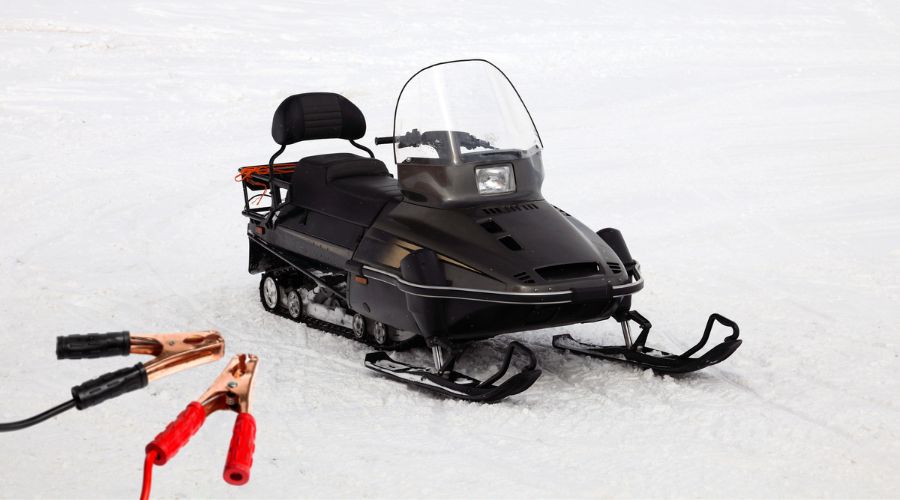Jumpstarting snowmobiles is generally not recommended, but you may not have another option in an emergency. The power surge from jumpstarting a battery can affect your integrated electronics. Although it’s not guaranteed to cause problems, it can sometimes.
How do you jumpstart a snowmobile? Read on, and I will teach you everything you need to know in case you ever get stranded and have no other options.
Using jumper cables, you jumpstart a snowmobile by connecting a functional battery to your non-working battery. The red or positive clamps connect to the positive terminals on both batteries, and the negative side connects to the negative on the working battery while the unused end needs to be grounded. Doing this transfers a small charge from one battery to the other.
Table of Contents
Can You Jump Start A Snowmobile
You can jumpstart a snowmobile as long as it has a battery. The term jumpstart literally refers to the process of starting a drained battery by applying an electrical charge.
Typically this comes from another battery via a set of jumper cables, but there are other devices you can use to start your snowmobile engine in an emergency.
Starting a Snowmobile With No Battery Power
It’s important to know you can run a snowmobile without a battery, but you must replace it as soon as possible to avoid electrical issues.
There are two ways to run your sled without the battery power component.
First, you can use a jump box to replace the battery function. Secondly, you can pull-start most snowmobile models.
The battery runs features like lights and hand warmers. More importantly, it also starts the engine.
However, with a pull cord or jump box, you should be able to run the engine and get home to jump or replace your battery.
A jump box works a lot like jumper cables with two lines coming out that clamp on your snowmobile.
If you want to see the process, I recommend watching this video. HMS Workshop shows you how to start the sled in under 2 minutes using this simple device.
Pull-starting a snowmobile is similar to pull-starting most outdoor tools like lawnmowers.
Although many modern tools with engines have a battery-powered start, the chord pull quite literally turns the engine and makes it start running.
All you need to do for a pull start is grab the handle on the chord and pull it straight back quickly, but it will take a fair amount of strength to achieve this type of start.
To see this process in action, check out this video from DoobyBoy21.
Can I Jump A Snowmobile Battery With A Car Battery
You can jumpstart a snowmobile battery with a car battery. Both machines use a 12-volt battery.
Despite any visual differences, the power output is the same. Using too much power to try and start your snowmobile could cause damage or even leave you with a non-working battery.
Fortunately, most car batteries are a perfect match.
It is important to note that vehicles with a 24VDC cannot directly start your snowmobile.
As Marissa explains on Quora, “Direct jump start, not gonna happen. Most 24 VDC systems use two 12VDC batteries wired in series or banks of parallel wires with 12VDC batteries wired in series. You could use your car alternator to charge the system at 12 VDC by connecting to the positive and negative terminal of a single 12 VDC battery. Still, you’re using your car as a battery charger, which will take a long time.”
How To Start A Snowmobile With A Dead Battery
Before I explain how to jumpstart a snowmobile with a dead battery, there’s a little basic information everyone should know.
To get power from one place to another using jumper cables, you must hook them up properly. This means using the positive side of both battery terminals with the positive side of the cable.
Finding the positive and negative is easy but also essential. If you misconnect things, your battery will not charge at best, and at worst, you could do significant damage and end up with two non-working batteries.
The positives on batteries and cables are usually marked with a plus “+” symbol or the color red.
The cables will have matching red (positive) and black (negative) sides. Negative terminals will be marked with a minus “-” symbol.
Please never reverse the cables or cross your connections from positive to negative.
Additionally, the negative cable clips to the charged battery only. The other end needs to be grounded, so I’ll explain where to put that in the steps below.
Jumpstarting a Snowmobile Step By Step
Jumpstarting your snowmobile is easy enough that anyone can do it with minimal knowledge and very little equipment.
You will need a set of jumper cables, a dead snowmobile, and a working 12-volt battery. It is crucial to use a 12-volt because the power output will match your sled.
Another snowmobile or even a car should have all the power you need.
Please follow the steps exactly and never touch the metal clamps with your hands for the safest possible jumpstart.
- Please turn off your snowmobile and the vehicle you plan to use to jumpstart it.
- Remove the keys from both vehicles to prevent accidental ignition.
- Open your hood, so you have access to your battery. Don’t forget to prop it up as necessary so you don’t accidentally smash your head, fingers, or cables. The other vehicle should do the same.
- (Optional) I recommend carrying a NOCO Boost Sport GB20 500 Amp 12-Volt UltraSafe Lithium Jump Starter Box from amazon in case no other working vehicle is available. If you use this alternative, skip steps 6 and 7.
- Start Dead Batteries – Safely jump start a dead battery in seconds with this compact, yet powerful, 500-amp lithium battery jump starter – up to 20 jump starts on a single charge – and rated for gasoline engines up to 4.0-liters.
- UltraSafe – Safe and easy-to-use car jumper starter and jump pack without worrying about incorrect connections or sparks. Safely connect to any 12-volt vehicle with our mistake-proof design featuring spark-proof technology and reverse polarity protection.
- Multi-Function – It’s a car jump starter, portable power bank, and LED flashlight. Recharge smartphones, tablets, and other USB devices. It’s easily rechargeable from any powered USB port in 3-hours at 2.1-amps. Plus, an integrated 100-lumen LED flashlight with seven light modes, including emergency strobe and SOS.
- Advanced Design – Our most advanced car battery charger jump starter ever. Featuring high-discharge lithium technology for safe operation in any climate. A rugged and water-resistant enclosure rated at IP65. A rubberized over-molded casing to prevent scratching or marring of surfaces. And an ultra-compact and lightweight design weighing just 2.4 pounds.
- In The Box – GB20 UltraSafe Portable Car Jump Starter, Heavy Duty Booster Clamps, Micro USB Charging Cable, Microfiber Storage Bag, User Guide, 1-Year Warranty, and Designed in the USA.
Last update on 2024-04-19 / Affiliate links / Images from Amazon Product Advertising API
- Attach one red (positive) side of the jumper cable to the positive terminal on the dead battery. There may be a cap covering this terminal on either battery. If this is the case, you must remove the caps before clamping the terminal.
- Next, you need to attach the other side of the red (positive) cable to the working battery.
- Attach one black (negative) clamp to the negative terminal on the working battery.
- Do not attach the negative cable to the negative terminal on the dead battery! The final clamp needs to be grounded. You can ground this clamp by attaching it to a piece of unpainted metal inside your hood. Ensure the metal you choose can handle the pressure and that it is not a moving part.
- Turn on the working vehicle only. You should run the working car or snowmobile for about 3 minutes.
- Turn off the working vehicle, then remove the clamps in the opposite order. Begin with the ground, then the negative terminals, followed by the positive terminal on the functional vehicle, and lastly, the positive cable on the formerly dead battery. Remember to keep all the clamps apart, so they do not touch.
- Put away the cables and run both vehicles for about 15 minutes to fully charge both batteries.
Pro Tip: Never allow the clamps of connected cables to touch each other or anything else. Accidentally bumping a live clamp on something, especially another clamp end, can cause an electrical spark that can explode batteries.
Helpful Tips To Know About How To Jump Start A Snowmobile
Jumpstarting your sled is not a complicated procedure, but every step is vital and must be done correctly if you want to succeed. It should only take a few minutes to get your machine up and running again.
Here are a few more helpful tips to know about how to jumpstart a snowmobile.
- The positive battery terminal is often, but not always, on the right-hand side when facing the front of the battery. Since it’s not universal, paying close attention to where you hook your cables is always necessary.
- The positive terminal on your battery might be larger or have a cover. Although there is no universal standard, many manufacturers choose to do this to help indicate where the positive terminal is located.
- Connecting batteries backward or diagonally (positive to negative) can cause the battery to melt. Not only will this leave you with a non-working battery that you cannot repair, but it can cause other problems, especially if you have a lead-acid battery, as many cars do. A melted lead-acid battery can release hydrogen gas. As Byjus explains, “… hydrogen is harmful to humans. If hydrogen is inhaled in small concentrations, it can cause symptoms like headache, nausea, irritation in the skin and eye, and convulsions. Inhalation of high concentration of hydrogen can cause asphyxiation.”
- Jumpstarting a vehicle such as a snowmobile properly will not harm or drain the other battery. You are borrowing some of the charge, but not all of it, to make your battery spark again. Running the engines will quickly recharge the batteries, and the donor battery will be no worse off for having helped.
Final Thoughts
Hopefully, you will never have to worry about a dead snowmobile battery; if you do, may it be when you are safe at home.
Jumpstarting a snowmobile is not the best option, but it may someday be your only choice if you’re on a mountain trail far from the nearest roads.
Remember to turn off the other vehicle, and never let the clamps touch your skin or each other.
If you follow the steps above, you should be able to get your snowmobile going again in no time.


